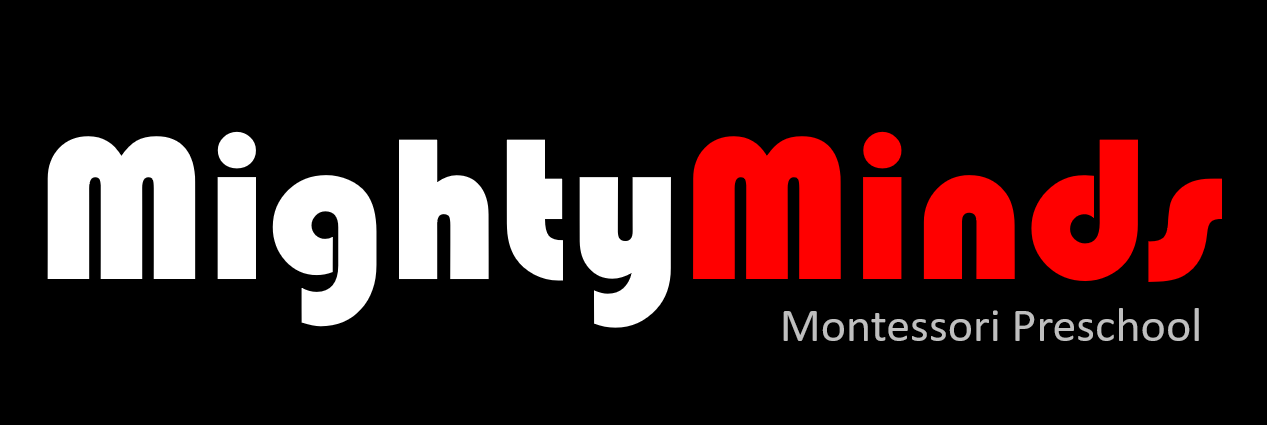Curriculum
At Mighty Minds we follow a standard daily curriculum as routine assists children in their learning.
All learning happens in accordance with Montessori Best Practice.
Subjects include: Mathematics, English Language, Social Skills, Cultural Studies (Geography & History), Sensorial Development, Science (Biology, Chemistry & Physics), Practical Life Skills, Art and Music, and Outdoor skills.

Our daily morning routine includes Montessori teaching activities, group activities, snack time and play time. For full-day students our extended programme also includes aftercare, lunch, nap time, and multimedia.
Juice is provided for all students during the break time, and lunch is provided for students staying for aftercare – parents are requested to send a healthy midmorning snack for their kids.
The classroom(s) consists of readily available games and toys, household utensils, plants and animals that are used to develop the child’s motor abilities together with sensory and intellectual capacities. In addition, the classroom(s) have been designed to encourage the child’s freedom, dignity and independence. The general atmosphere is of children doing things for themselves carefully and competently.
Mathematics
Here children gain a physical impression of size and quantity by handling number rods, counting out beads, counting spindles into boxes and arranging coloured counters in patterns – odd and even numbers. Numbers are built up using plastic beads and their sandpaper symbols traced with the fingers. Pie-shaped frames with inset pieces give concrete grounding in fractions, which the child can refer back to in years to come.
Language
The reading program progresses through three levels: pink, blue and green – reading materials are colour coded for each level. Inside a small pink box, a child finds a tiny toy dog. She takes it out, says the word, listens to the sounds in it and then seeks out the letters, which make those sounds to build the word. Writing skills are acquired by colouring intricate shapes drawn with metal insets, and sandpaper letters are experienced by touch as well as by sight and sound. A wide range of story and reference picture books are always available in the classroom.

Sensorial
This part of the classroom is used to develop the child’s senses. Equipment includes – pink tower blocks, cylinders graded in size, cylinders with knobs, rough and smooth plates in boxes, smelling bottles, fabrics to sort by touch and puzzle blocks called the binomial and trinomial cubes. Materials are used to prepare the muscles of the hand for writing, the ear for hearing fine differences in sound (for distinguishing between letter sounds) and sight (for recognizing letter and number shapes).

Cultural (Geography and History)
This part of the classroom includes:
- Maps, globes and flags – where children learn about parts of the world and it’s history.
- Culture – where children can examine artifacts from other cultures such as a Japanese fan, chopsticks, an Indian sari or an African drum.
- On festival days, we celebrate with tastes of exotic foods, learn songs from other countries or invite a guest or parent to show and tell about special costumes and celebrations.
- Land forms – to teach geographical features (a set of models showing islands, bays, capes, peninsulas and lakes for children to fill with water and perhaps float a little boat or put an animal on the land)
- Solar system – to examine the various planets and their features.
Science (Biology, Chemistry and Physics)
This section includes a wide range of experiment materials including magnets, leaf shapes, different kinds of stone, immersion and immiscible liquids etc. There are even simple circuit boards and computer hardware (disk drives, motherboards etc). The fish tank is used to introduce the concept of habitat and the ecosystem.

Practical life (“Life-skills”)
Here children develop their ability to look after themselves and their surroundings. They can practice dressing skills on specially made frames that allow them to try zips, buttons, bows and buckles. They use little jugs filled with beans or rice and then water to practice pouring; they spoon, scoop, or use droppers, tweezers and chopsticks to transfer from one bowl to another. Other activities use scaled down versions of real equipment: brushes and brooms, wash-up bowls and cloths, cleaning and polishing kits, a tiny safe iron and ironing board. There are also varied opportunities for paring socks, folding and sorting clothes, setting a table, plaiting and sewing – even packing a tiny suitcase. Their added purpose is that these real tasks, which involve the hand and the mind together, develop a great capacity to concentrate – which serves as good preparation for the intellectual work to come.

Art and music
Painting and drawing takes place in a special “Painting Area”, where creativity and imagination are encouraged.
Music sessions include performing, dancing, singing and experimenting with different instruments. Sounds of the ocean, river waters, birds singing and animals are also used in the curriculum.
Outdoors
Being outdoors is very important. Children develop gross motor skills as they climb, jump, swing, and social skills as they take turns on equipment and play hide and seek. We believe strongly that children should be in touch with the substance of their world, encouraging work with clay, gardening, growing activities and even building little sand castles.

Social skills
Children are not born with an innate knowledge of why we shake hands, or kiss, or rub noses depending on our culture – and in the Montessori classroom they learn appropriate greetings. As they become aware of other cultures, they are encouraged to celebrate differences and value them equally. During circle time children are shown how to move quietly and carefully around the classroom, push in chairs, wait patiently before politely gaining someone’s attention and are reminded how important it is to allow others to work undisturbed. These ground rules in the classroom give every child total security. Children also learn to notice if somebody needs help and that nobody is too small to be useful.

